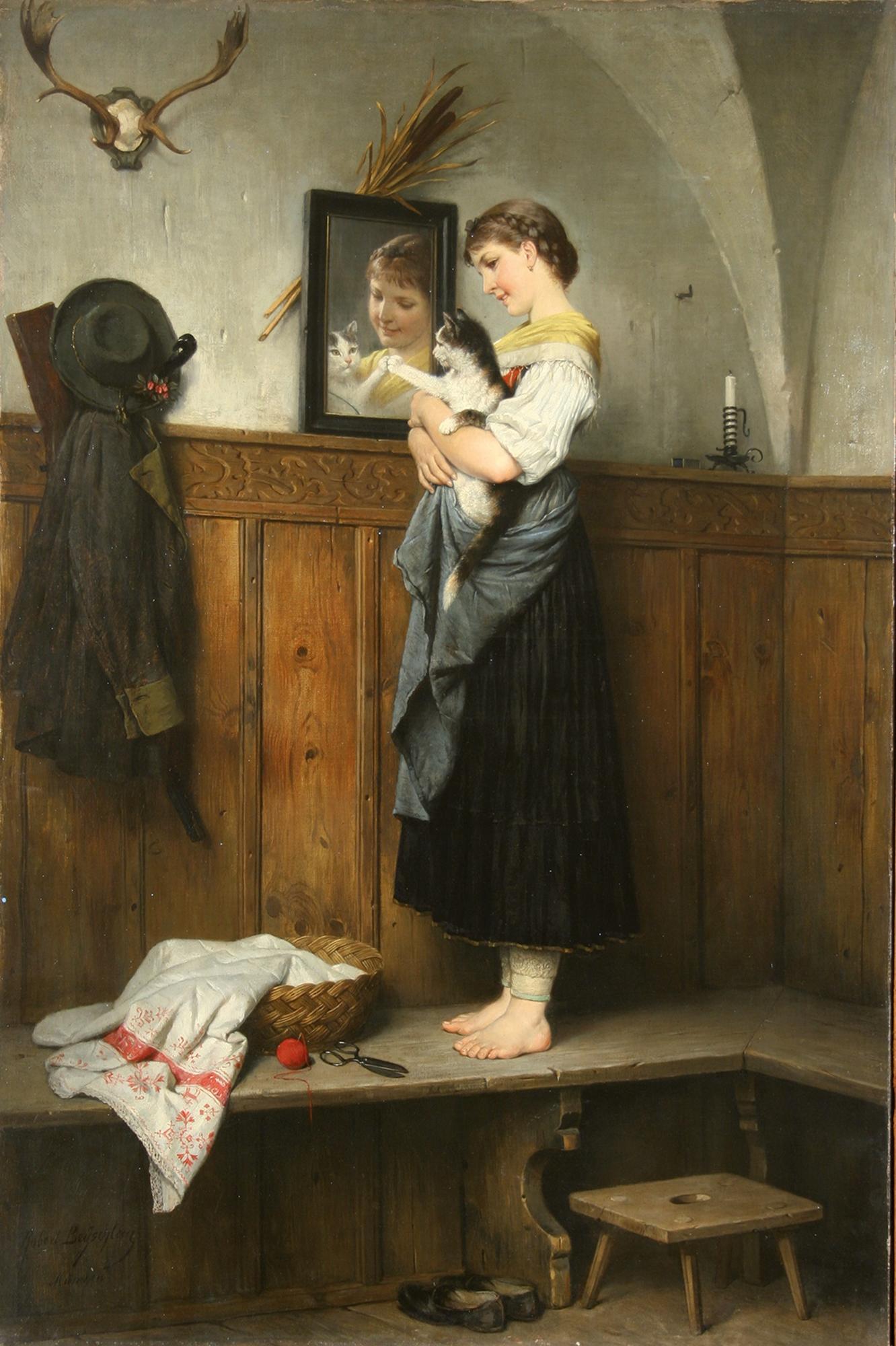German genre painter Robert Julius Beyschlag (1838−1903) studied with Philipp Foltz at the Munich Academy of Arts, an institution famous for the education of a whole generation of talented artists.
‘Girl with a Cat’ from the Omsk Museum collection represents the domestic genre widely developed in 19th century Germany, which includes the features of realism and Biedermeier art. The work is full of unpretentious, but expressive details of the young woman’s daily life.
Biedermeier’s ideological background lies in the unstable political situation in Germany and Austria during the period of political reaction and crisis in the major art forms. The anxious situation and melancholy moods in society aroused the desire to immerse in the aesthetics of one’s private circle of family and friends, and to find creative inspiration in the joys of common daily life. The painting of this period depicts domestic scenes, which detach the viewer from the harsh reality and present the appeal of the ordinary human being’s world.
The female characters of Robert Beyschlag’s lyrical paintings are beautiful young women playing with children, doing needlework, or longing for a date. This exquisite drawing has a rich color palette, a light compelling plot, and is full of optimism and good humor, features that made Beyschlag one of the most popular artists of his time.
The painting of the Omsk Museum comes from the collection of the noble Yusupovs’ family that was well known as great art collectors. The last owners of the canvas were Zinaida and Felix Yusupovs. In 1900 they made a will for themselves and their minor sons, Nikolai and Felix, in case of ‘sudden death of the family members.’ They bequeathed all their movable property to the state, in order ‘to preserve these collections within the Empire, for the satisfaction of the aesthetic and scientific needs of the Motherland.’ Fate, however, had other plans. In 1919, the Yusupovs collection was nationalized and became the basis for the Art museum in Petrograd at the Moika Palace (the Former Yusupov Gallery), and for the Arkhangelskoye estate in the Moscow Region. In 1925, the Yusupov collection ceased to exist as a single collection. The art works were removed from the palaces and transferred to the State Museum Collection. Nowadays, the artistic values from the Yusupovs collection are kept in the State Hermitage Museum, the Pushkin State Museum of Fine Arts, the Arkhangelskoye Estate Museum, and others.
‘Girl with a Cat’ from the Omsk Museum collection represents the domestic genre widely developed in 19th century Germany, which includes the features of realism and Biedermeier art. The work is full of unpretentious, but expressive details of the young woman’s daily life.
Biedermeier’s ideological background lies in the unstable political situation in Germany and Austria during the period of political reaction and crisis in the major art forms. The anxious situation and melancholy moods in society aroused the desire to immerse in the aesthetics of one’s private circle of family and friends, and to find creative inspiration in the joys of common daily life. The painting of this period depicts domestic scenes, which detach the viewer from the harsh reality and present the appeal of the ordinary human being’s world.
The female characters of Robert Beyschlag’s lyrical paintings are beautiful young women playing with children, doing needlework, or longing for a date. This exquisite drawing has a rich color palette, a light compelling plot, and is full of optimism and good humor, features that made Beyschlag one of the most popular artists of his time.
The painting of the Omsk Museum comes from the collection of the noble Yusupovs’ family that was well known as great art collectors. The last owners of the canvas were Zinaida and Felix Yusupovs. In 1900 they made a will for themselves and their minor sons, Nikolai and Felix, in case of ‘sudden death of the family members.’ They bequeathed all their movable property to the state, in order ‘to preserve these collections within the Empire, for the satisfaction of the aesthetic and scientific needs of the Motherland.’ Fate, however, had other plans. In 1919, the Yusupovs collection was nationalized and became the basis for the Art museum in Petrograd at the Moika Palace (the Former Yusupov Gallery), and for the Arkhangelskoye estate in the Moscow Region. In 1925, the Yusupov collection ceased to exist as a single collection. The art works were removed from the palaces and transferred to the State Museum Collection. Nowadays, the artistic values from the Yusupovs collection are kept in the State Hermitage Museum, the Pushkin State Museum of Fine Arts, the Arkhangelskoye Estate Museum, and others.



